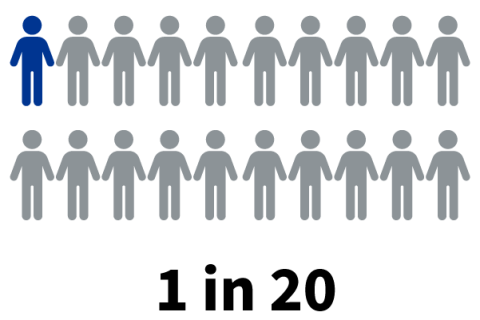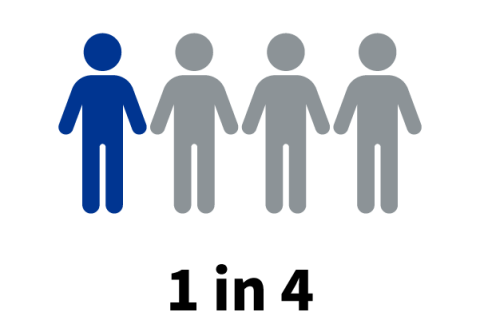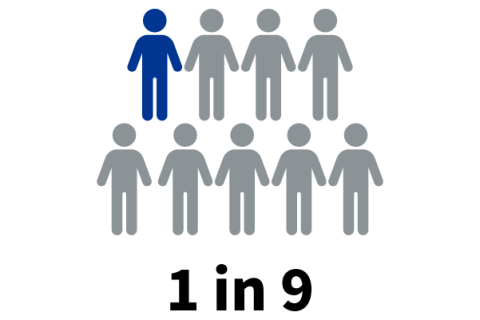“Being [disabled] in the state of New Hampshire shouldn’t limit me to starvation.”
- Portsmouth, NH resident with a disability
Introduction
People with disabilities are at an increased risk of food insecurity. Financial challenges are the primary barrier to having enough food. Transportation, accessibility, and disability public policies create additional barriers for New Hampshire (NH) residents with disabilities. This needs assessment describes the NH disability population through U.S. Census Bureau statistics and includes quotes from conversations with NH residents who have a disability to describe barriers to accessing enough food.

1 in 5 NH adults with disabilities are food insecure.

1 in 20 NH adults without disabilities are food insecure
*Based on U.S. Census Bureau Household Pulse Survey data (July 2021-May 2022), for NH residents 18+ years old.
How are we measuring food insecurity?
Food insecurity is usually measured by asking up to 10 survey questions of people who live in households with lower incomes. In this report, we're relying on a simplified measure that uses just one of these questions where people report that they "sometimes" or "often” did not have enough to eat in the last seven days. Food insecurity affects 75,000 of the 1.4 million New Hampshire residents.1,2
- Food security: when a family does not have “access to enough good… at all times to live an active and healthy life” and is “limited by a lack of money and other resources.” In this report, we state individual-level reports of food access rather than household-level measures.
How Can Having a Disability Affect Food Insecurity
Poor Health and Nutrition
Food insecurity can affect many parts of a person’s life, including health and nutrition. The links between food security status and nutrition are well-studied. There are strong associations between low diet quality, higher chronic disease risk (i.e., diabetes, heart disease, obesity), and food insecurity.4,5 For people with disabilities, who are already at high risk for chronic disease and poor health, having food insecurity puts them at an even higher risk for these health outcomes. This worsens the nation’s public health status and can negatively impacts quality of life.6
“I have three, four different specialized medical diets...I think that they should give people with chronic issues...options to buy more [fresh] fruit and vegetables...that is the first thing [the doctors] tell you to buy...and I did not have the money to buy that.”
-Manchester, NH resident with a disability
Inaccessible spaces can prevent people from getting and cooking healthy foods
Accessibility can be a problem when individuals arrive at their grocery store or food pantry. Some stores may have checkout lines and aisles that are too narrow for wheelchairs. Other stores may place items on shelves that are not reachable by all shoppers. Accessibility can be a barrier when individuals are in their own homes. Individuals report difficulty preparing food at home, often relying on pre-made salads and meals offered at the grocery store. However, some prepared foods have restrictions when using SNAP benefits.
Food pantries are a valuable community resource for low-income individuals and families. When people with disabilities were asked about their experience utilizing pantries, they reported some challenges. One individual said accessibility is an issue, as the food pantry they visited was in a basement. There is also concern about the nutrition of the foods offered. Another person reported that there was a lack of fresh food and the food available was not very nutritious.
- Supplemental Nutrition Assistance Program (SNAP): is the largest federal nutrition assistance program that provides monetary benefits for food-insecure individuals and families to purchase eligible foods
Lack of reliable transportation is a barrier
People with disabilities are less likely to have a car. This can mean that they are more reliant on public transportation or finding a ride with a friend or family member to carry out routine tasks such as food shopping. Due to inaccessible environments and more limited travel options, people with disabilities also take longer, on average, for trips. Having fewer choices for transportation may mean that people with disabilities have to organize shopping trips around the schedules and drop off locations that are not convenient for them. Challenges with planning trips and paying for trips may make food shopping more difficult for those who do not have a car.
“The biggest challenge that I face,…[before owning a vehicle]..had been getting to the physical pantry itself for food.”
-Portsmouth, NH resident with a disability
Lower Employment Rates and Pay
Underemployment and unemployment have significant impact on accessing food. Persons with disabilities also have higher unemployment rates and lower wages than persons without disabilities, which can limit the amount and types of food they can afford.6 In the state of New Hampshire, 1 in 8 individuals reports having a disability, or just over 12% of the population.2

One in four people with a disability lives at or below the federal poverty line

One in nine people without a disability lives at or below the federal poverty line
Assistance programs don’t provide enough support
The Supplemental Nutrition Assistance Program (SNAP) is the largest federal nutrition assistance program that provides monetary benefits for food-insecure individuals and families to purchase eligible foods. Certain protections are in place that give individuals with disabilities an increased likelihood of qualifying.7 However, the monthly benefits are usually not enough to cover the grocery bill. In fiscal year 2018 in New Hampshire, the average SNAP benefit was $193, less than the U.S. average of $239.8 The COVID-19 pandemic saw large increases in food insecurity rates across all populations, including disability.9
In response, the federal government raised every qualifying household to the maximum benefit for their household size. For example, a family of three who was receiving $449 per month pre-pandemic, was receiving $693 per month after the adjustments and added boosts were accounted for. However, the federal emergency allotment of SNAP benefit was ended at the beginning of March 2023, cutting these increased benefits down to amounts similar to pre-pandemic.10 For many, these changes are drastic and may require significant lifestyle adjustments by some households to accommodate the smaller monetary allotment. The SNAP benefit reduction showcases the need to ensure adequate supports are available from other organizations to ensure food is available through a variety of means to support these households.
“I’m on a very restrictive income with Social Security...I cannot literally feed myself monthly...I literally have less than $200 after...all my bills are paid for food and food only. I cannot spend it on anything else. If...I need a new tire, I have dip into my...food fund and there go groceries for the month. So the pantry keeps me alive.”
-Portsmouth, NH resident with a disability
Social security income provides further financial assistance for people with disabilities and is a valuable resource for those who qualify. The benefits are reserved for those who both meet the disability requirements to qualify and have a limited income. Unlike SNAP, Social Security benefits come in monetary form, so direct recipients of it may use the money as they wish, including buying groceries and paying bills.11
Despite the legal protections and federal and local assistance programs, persons with disabilities continue to experience increased rates of poverty and other economic disadvantages, including food insecurity, and New Hampshire is no exception.12 Further supports and systems need to be developed to lessen food insecurity’s impact in the Granite State.
Resources
For People with Disabilities
- Supplemental Nutrition Assistance Program (SNAP)
SNAP provides nutrition benefits for income-eligible residents. - Food Pantries
Refer to the New Hampshire Food Bank’s website for a map of NH food pantry locations. - SNAP-Ed
SNAP-Ed is an educational program to help SNAP recipients learn about meal preparation, shopping, and nutrition. The goal is to “[promote] healthy food choices and physical activity consistent with the most recent dietary guidelines for Americans.”
For Policy Makers and Food Pantries
- Simplified enrollment for SNAP
In some states, SNAP operates a simplified enrollment program for elderly residents, minimizing the application burden so that more older people who need nutrition support can receive it.13 This may be considered in NH and we would benefit by expanding to include the disability population, many of whom may be overburdened by the regular application process. - Collecting data on your patrons
Does your program capture the demographics of the community you serve? Measuring the disability status of your patrons can help to inform your diversity, equity, inclusion, and accessibility reach. - Accessibility assessment
Is your program and physical space accessible to everyone in your community? There are evaluation tools, including the National Center on Health, Physical Activity and Disability (NCHPAD)’s Community Health Inclusion Index (CHII) that can be used to consider programmatic and environmental barriers you may not have considered. The NH Disability and Health Program can also help with this process. Email us for technical assistance
Data and Methodology
This brief report considers the specific issue of food access for adults with disabilities in New Hampshire.
Findings from this assessment will be used to inform the strategies of the NH Disability and Health Program (DHP) to fill gaps and address barriers to preventive health care, health promotion opportunities, and engagement in healthy behaviors.
Disability was defined as anyone reporting having “a lot of difficulty” or “cannot do at all” in response to questions about mobility, cognition, hearing, or seeing. The findings in this document come from the authors’ analyses of the U.S. Census Bureau's Household Pulse Survey (pooled data from July 21, 2021 to May 9, 2022) for respondents residing in New Hampshire.
The measure of food insecurity summarized here is a narrow measure generally referred to as “food insufficiency” in the Household Pulse Survey. It assesses food inadequacy.14
Qualitative data appear throughout this report. We are grateful to the individuals who have shared their stories with us and given us permission to use quotes that bring the statistics to life and illustrate impact.
Suggested citation: Stott, G., Henly, M., & Poehlman, E. (2023). Food Security for Adults with Disabilities in New Hampshire. University of New Hampshire. Institute on Disability: Durham, NH
References
- Coleman-Jensen A. Household Food Security in the United States in 2021. Published online 2021:51.
- U.S. Census Bureau QuickFacts: New Hampshire. Accessed November 2, 2022.
- Gregory CA, Coleman-Jensen A, eds. Food Insecurity, Chronic Disease, and Health Among Working-Age Adults.; 2017. doi: 10.22.004/ag.econ.261813
- Morales ME, Berkowitz SA. The Relationship between Food Insecurity, Dietary Patterns, and Obesity. Current nutrition reports. 2016; 5(1):54. Doi:10.1007/s13668-016-0153-y
- Disability. Accessed September 26, 2023.
- Brucker DL, Coleman-Jensen A. Food Insecurity Across the Adult Life Span for Persons with Disabilities. Journal of Disability Policy Studies. 2017; 28 (2): 109-118. doi: 10.1177/1044207317710701
- Getting SNAP on Disability: What You Need to Know. Accessed January 5, 2023.
- SNAP household state averages for SNAP benefits (FY 2018) | Food and Nutrition Service. Accessed January 5, 2023.
- Brucker DL, Stott G, Phillips KG. Food sufficiency and the utilization of free food resources for working-age Americans with disabilities during the COVID-19 pandemic. Disability and Health Journal. 202;14(4):101153. doi:10.1016/j.dhjo.2021.101153
- SNAP Benefits: The COVID-19 Pandemic and Beyond. U.S. Department of Agriculture Accessed January 5, 2023.
- Disability Benefits | SSA. Accessed March 2, 2023.
- Coleman-Jensen A, Nord M. Food Insecurity Among Households with Working-Age Adults with Disabilities. SSRN Journal. Published online 2013. Doi:10.2139/ssrn.2202869
- Elderly Simplified Application Project | Food and Nutrition Service. Accessed September 25, 2023.
- About SNAP-Ed. U.S. Department of Agriculture. Accessed November 22, 2023.
Funding Statement
This NH Disability & Health Program report was made possible by cooperative agreement DD000025 from the U.S. Centers for Disease Control and Prevention (CDC). Its contents are solely the responsibility of the authors and do not necessarily represent the official views of the the CDC or the U.S. Department of Health and Human Services.